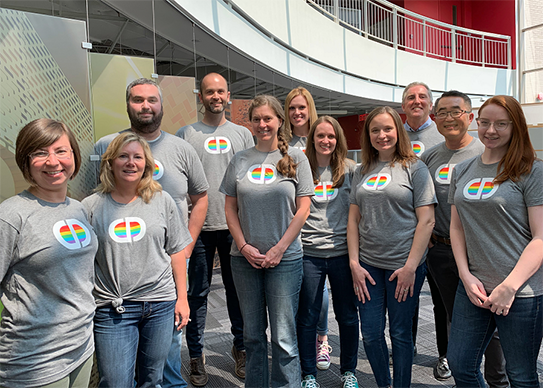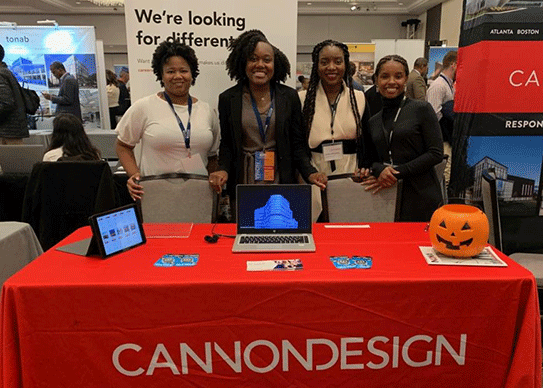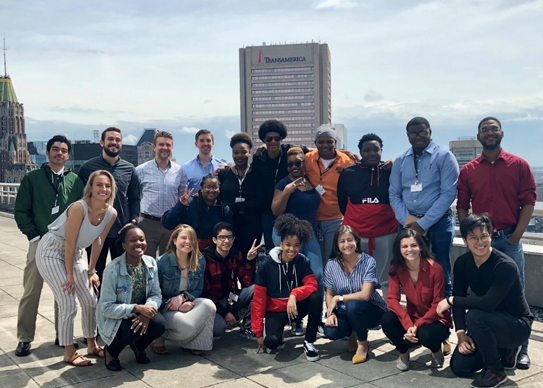That’s the kind of architect recent Kent State University graduate Walter Hunt wants to become. To him, architecture isn’t just about form and beauty. It’s about impact and the opportunity to improve life for those who need it most.
This drive—to use architecture to catalyze social change—was the resounding message each of our fellows from the National Organization of Minority Architects (NOMA) Foundation Fellowship shared when asked about the types of architects they want to become. The fellowship program seeks to increase minority licensure within the architecture industry, and our firm was honored to host three fellows this year. We sat down with each of them virtually to learn more about their experiences and their aspirations as they grow in their careers.
Walter Hunt
Walter’s interest in architecture started in childhood. He was always drawing in his sketchpad, and one day his grandmother picked up one of his pieces and said a few words that changed his life: “You’re going to be an architect.” Those words had an incredible impact on Walter, encouraging him to participate in the ACE Mentoring program in high school and eventually leading him to pursue a degree in architecture.
 A recent graduate of Kent State University’s architecture program, Walter focused much of his college experience on connecting with the community and building a professional network. On top of having two full-time jobs, he held an internship, participated in design competitions, became a leader in Kent’s NOMA student chapter and volunteered with the ACE mentorship program, giving him an amazing opportunity to give back to a program that impacted him so much. “If underrepresented groups see more people like them in the classroom, we can inspire them to do great,” he said.
A recent graduate of Kent State University’s architecture program, Walter focused much of his college experience on connecting with the community and building a professional network. On top of having two full-time jobs, he held an internship, participated in design competitions, became a leader in Kent’s NOMA student chapter and volunteered with the ACE mentorship program, giving him an amazing opportunity to give back to a program that impacted him so much. “If underrepresented groups see more people like them in the classroom, we can inspire them to do great,” he said.
Although Walter had planned to physically be in our Los Angeles office this summer, the pandemic led to a virtual fellowship where he’s working with our LA office from his home in Akron, Ohio. He’s focused on a research project examining how technology is being integrated into learning environments across all 23 campuses at California State University. Working closely with CannonDesign’s Craig Hamilton and Jaime Rivera, he’s exploring how this technology might be better utilized to support collaboration and bring people together physically and virtually.
Looking ahead to his future, Walter plans on getting his master’s degree and eventually having his own integrated practice. “I want to be a relatable architect that is connected to the community. I want to walk in people’s shoes before I design for them.”
Tyler Sauter
Tyler grew up in rural Washington. As a child, he was passionate about painting and drawing, but didn’t realize the opportunities that existed with architecture until college. After a short stint taking engineering classes, he found himself getting pulled back to art—taking drawing and sculpture courses and eventually applying to architecture school.
 After getting accepted to the architecture program at Illinois Institute of Technology (IIT), Tyler packed up his suitcase and flew to Chicago for his first experience living in a big city. He really bought into the whole pedagogy at IIT, and during his second year, he helped start a NOMA student chapter. As president, he planned a number of student events, from resume and portfolio reviews to a presentation series where upper-level students shared their internship experiences with younger students.
After getting accepted to the architecture program at Illinois Institute of Technology (IIT), Tyler packed up his suitcase and flew to Chicago for his first experience living in a big city. He really bought into the whole pedagogy at IIT, and during his second year, he helped start a NOMA student chapter. As president, he planned a number of student events, from resume and portfolio reviews to a presentation series where upper-level students shared their internship experiences with younger students.
As Tyler progressed through architecture school, his passion increasingly grew towards public interest design. He sees architecture as a tool to advocate for neighborhoods and disadvantaged populations—from the building scale all the way to the community scale. This passion is seen in the research project he’s supporting at CannonDesign; he’s helping develop a holistic approach to care at homeless shelters.
“We’re looking at policies and programs that are existing, but we’re also exploring entirely new models that introduce new typologies and programs that combine health, housing, nutrition and more,” he said. “The need for a new approach has become especially evident in the midst of COVID-19. The homeless population is uniquely vulnerable to contracting COVID-19, and to experiencing harsher effects of the virus.”
As part of his research, Tyler was able to virtually meet with a local homeless shelter to present his research. “The feedback was amazing,” he said. “They provided their first-hand understanding of what it’s like running a shelter and what the procedures are. You can’t fully understand the day-to-day operations of a shelter without this first-hand insight.”
Reflecting on his experience being a virtual fellow during a global pandemic, Tyler laughed and said he’s become good friends with his CannonDesign mentor, Bobby Vance, even though they’ve never met in person. The two of them meet twice a week, and in between meetings, Tyler focuses on developing drawings, graphics and diagrams that bring the research he’s conducting to life.
Now that Tyler’s done with school, he’s been busy applying for jobs and exploring political advocacy. Wherever he ends up, his goal is clear: “I want to work on projects that make a difference for the many.”
Nancy Guerrero
Nancy Guerrero’s passion for architecture stems from her deep passion to help reshape communities. Her recent internship with our Houston office empowered her to pursue that passion while also learning a great deal about the profession.

During her months with CannonDesign, Nancy took part in virtual design and construction sessions with contractors for work with Kaiser Permanente, she joined a contract administration team for a new women and children’s facility with Dignity Health, and worked on furniture for a key education project.
Nancy also connected with Kent Muirhead, a design leader in our Baltimore office, who guided her through a personal design project. The intent was to have her select a community-based project to develop during any down time during the summer experience. The effort included regular design pin ups with her office and design leader.
“The project allowed me to look at a problem in my neighborhood and then explore how it might become better through a design solution,” Nancy explains. “I looked at crime and how design might be able to strengthen education and ultimately reduce our community crime challenges.”
Through her project, Nancy developed concepts for a new performing arts center for area-youth that would provide new ways for them to engage, learn and be productive. She felt this level of engagement would help reduce crime.
“Nancy did an incredible job,” explained Alex Kristiansen, her internship manager. “She made our Houston team stronger all summer on multiple fronts and her project allowed her to put her full creative skills on display. She inspired us.”
Already a graduate of Prarie View A&M, Nancy now heads to Texas A&M University to complete her Master’s in Architecture. She says she wants to “graduate, get licensed and make a difference.”




